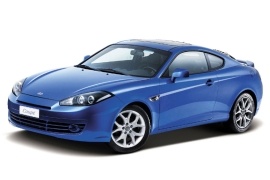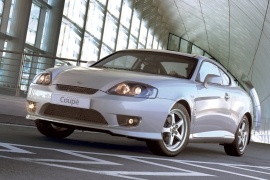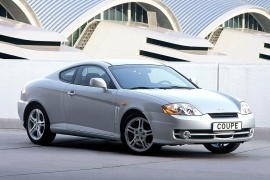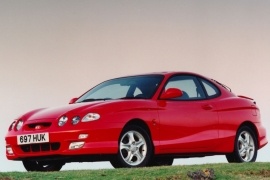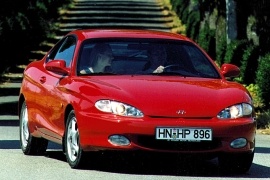HYUNDAI Coupe / Tiburon Models/Series Timeline, Specifications & Photos
First production year: 1996
Engines: Gasoline
Body style: Coupé (two-door)
Hyundai’s way to the sport-coupe world was represented by their Coupe model (also called the Tiburon). Already a habit for Hyundai, they offered a stellar warranty and great features for lower prices compared to the competitors on the market.
The 2007 model came with a revamped from and rear end, such as new taillights, new headlights and also refreshed exhaust pipes.
The Tiburon came in three four levels, the GS, the GT, the GT Limited and the SE.
Standard equipment for 2007 included a tire-pressure monitoring system, A/C, keyless entry, fog lamps and 16-inch alloys. If opted for the GT trim level, the Tiburon had additional automatic climate control, leather-wrapped steering wheel, cruise control, a trip computer and bigger 17-inch alloys.
Going further to the upper trim levels, the GT Limited came with red leather upholstery, a power sunroof and a better quality Infinity audio system. The sportiest version came with the SE equipment level and offered a tweaked suspension, a rear spoiler, aluminum pedals, red callipers and a 6-speed manual transmission.
While the base version came with a 2.0-liter engine that developed only 138 hp, the higher trims ran on a 2.7-liter V6 that cranked out 172 hp. The 2.7-liter engine was still considered to develop less power than expected compared to other sporty options on the market.
In 2004, Hyundai introduced a facelifted version for its Coupe/Tiburon model and offered it with more powerful engines, and removed the 1.6-liter version.
By 2004, the Coupe was one of the last budget-coupe vehicles on the market after the Ford Probe and the Toyota Celica's dismissal. The Korean carmaker noticed that and tried to make its car more attractive to the customers and improved the car's handling and powertrains.
There was a consistent change in the car's front design. Its smoked headlights and the trapezoidal grille in the lower bumper area showed an aggressive styling. The fog-lights were moved on individual pods on the outer sides of the apron. Behind the front wheels, the carmaker changed the vents' look with two horizontal slats instead of three vertical ones. Hyundai didn't stop there and changed the tailgates, introducing larger reversing lights. Depending on the engine option, the car featured a small wing on the trunk.
Inside, the carmaker introduced an upgraded design for the center stack, with digital controls for the climate-control unit. As part of its sporty-oriented vehicle, Hyundai kept the three gauges above the audio system. Its high-bolstered seats were appreciated even from the 2001 model, and they were kept. Like before, though, the rear seats were good only for leg-less dwarfs.
Under the hood, Hyundai dropped the 1.6-liter engine and offered the 2.0-liter version as the base level. Its top performer remained the 2.7-liter V-6 unit that provided 167 hp.
Hyundai had to come with something appealing to be taken seriously, and the Hyundai Coupe released in 2001 had the looks, offered reasonable performance and came with a competitive price.
The coupe was available with a choice of two engines, a 1.6-liter and a 2.0-liter unit. While the 1.6-liter did not provide an enormous acceleration, it still offered adequate power. The 2.0-liter powerplant developed 140 hp.
The engines were mated with a standard 5-speed manual gearbox or an optional automatic transmission at the extra cost of $800.
While most of the coupes equipped with a fully independent sports suspension, ABS and four-wheel disc brakes came at a higher price, the Tiburon kept it decent.
Worth mentioning, the Coupe came with an amazing warranty of 10 years / 160,000 km for powertrain and 5 years /160,000 km bumper to bumper.
Standard features included power windows, air-conditioning, 15-inch alloy wheels, a rear wiper and cloth upholstery. Leather upholstery and antilock brakes came with optional packages.
The cabin was fitted with improved materials and the interior had a sporty look. Specific to coupes, the rear seats did not offer enough legroom or headroom for tall people. However, the front occupants had great room.
The trunk was surprisingly roomy, thus going on a holiday with the fun-to-drive Coupe was easy.
Launched in 1995, the Tiburon managed to be successful on the coupe market due to its distinctive styling.
As the previous model had started to become dates, the coupe was in need of a complete makeover to keep its place on the market.
With the stylish exterior came a smart interior available with leather upholstery, twin airbags, power windows and mirrors, and even cruise control.
A great looking car with strong competition from Honda and Toyota, the Tiburon was not only about the looks, but also about the price. It was an affordable vehicle with many features not included with other models for higher prices.
Buyers could choose between a 1.6-liter or a 2.0-liter engine, developing 111 hp, respectively, 137 hp. Not the most powerful engines, they offered enough power to make the Tiburon a fun-to-drive vehicle.
Fuel economy was also one of the coupe’s strongest points.
The Hyundai Tiburon offered seating for 4, and even the trunk was a decent size for a coupe.
Adding to the list of strong points, the Tiburon was offered with the “Hyundai Advantage” program that included a 10 year or around 160,000 km warranty, with 5 year warranty or 160,000 km corrosion coverage, as well as a limited bumper-to-bumper warranty of 5 years or 160,000 km.
It was easy to get noticed driving a Tiburon, and that was mostly for the car’s distinctive styling.
ABS was optional with the upper trim level, the FX.
Hyundai unveiled in 1993 a concept-car named HCD-II, and the customers were pleasantly surprised, and that led to the carmaker's decision to give a green-light for the Tiburon/Coupe.
While still a new name on the market, Hyundai relentlessly tried to get more attention. It changed its car's models often, then other carmakers introduced facelifts and found a niche in the sport-coupe segment where it introduced the Tiburon/Coupe lineup. It was a tremendous success.
It was launched at the peak of the bio-design era, the sporty vehicle aimed at the Honda Civic coupe customers. Unlike its main rival, the Tiburon was designed as a coupe right from the start and didn't share any body panels with other sedan versions. Its sculptured lines on the fenders and slimmer mid-size section made it look faster than it actually was. At the front, the angled, ellipsoid headlights and slim grille formed an aerodynamic styling.
Inside, Hyundai said the car could accommodate four people, but there was hardly room for anyone in the back. At the front, it offered adequate room for average-sized adults. For the dashboard, Hyundai introduced a driver-oriented center stack and elliptic dials in the instrument cluster.
The Korean carmaker offered the Tiburon/Coupe with a two-engine choice paired as standard to a five-speed manual gearbox. A four-speed automatic was available for the 2.0-liter version.
